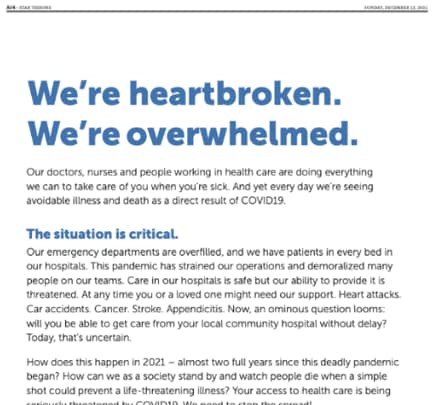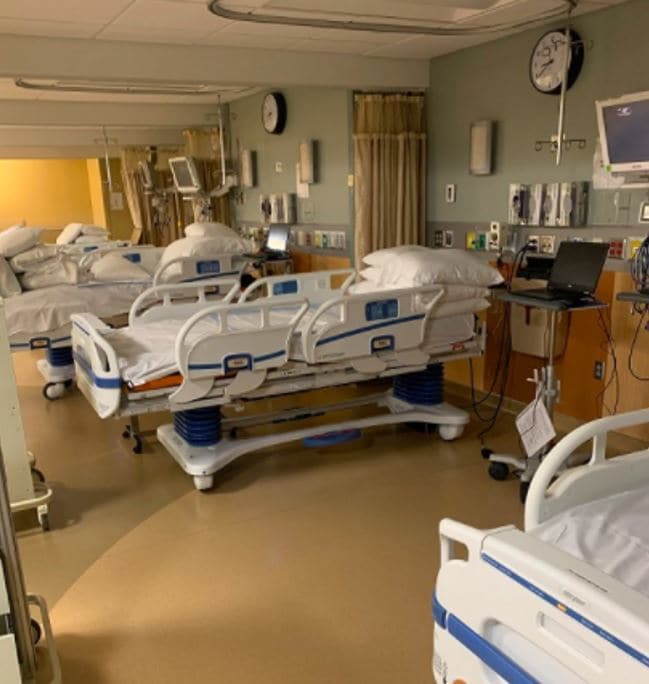Overwhelmed Minnesota Healthcare Workers Prepare for Another COVID-19 Winter
As temperatures fall and people begin moving from outdoor activities to gatherings indoors, public health experts are concerned COVID-19 cases could surge for a third year in a row. Cases in the United Kingdom and other European countries are increasing, and at times that has been an indicator for what is about to happen in the United States. While updated booster shots designed to target Omicron variants are now widely available, the Centers for Disease Control and Prevention (CDC) estimates only about 13 to 15 million people have received the new bivalent shot. As of the end of November, 2022, federal case counts aren’t showing a rise in the United States yet, but some health officials are worried that prevention is getting harder because fewer people are wearing masks, some people have pandemic fatigue, and many people don’t want to get the new Omicron-specific boosters. These factors greatly concern health officials heading into the third winter of the pandemic.

Over the last two-and-a-half years, emergency rooms across the United States were strained at unprecedented levels due to COVID-19. Doctors, advanced practice providers, and nurses in emergency and hospital inpatient units across many states were over-burdened. In some cases, 30-40% of the beds in emergency rooms were occupied with patients who suffered from COVID-19, with long waits for inpatient beds.
In Minnesota (MN), as in many states, healthcare workers prepare for what is ahead by looking back. The number of severe COVID-19 cases was so high during the 2021-2022 winter that the nine major healthcare Chief Executive Officers in MN came together in a full-page newspaper ad featured in the Minneapolis Star Tribune to plead with readers to get vaccinated against COVID-19 due to the surge in hospital demand. The article detailed how healthcare workers were exhausted, heartbroken, and overwhelmed after handling COVID-19 cases non-stop for almost two years. Minnesota emergency departments were overfilled and understaffed, and staff were overworked.
Hospitals across Minnesota lacked a mechanism to easily find available beds and lacked policy or agreements to make sure patients received necessary care.
Resources Stretched to the Limit
In November 2021, the emergency room at Hennepin County Medical Center (HCMC) in Minneapolis had a daily list of approximately 20 patients waiting for available inpatient beds. COVID-19 created pressure on inpatient health care capacity, particularly for intensive care resources. “Hospitals across Minnesota lacked a mechanism to easily find available beds and lacked policy or agreements to make sure patients received necessary care,” says Dr. John Hick, the Medical Director for emergency preparedness at Hennepin Healthcare. The hospitals urged people not to ignore the pandemic and to get vaccinated, wear a mask and get tested if they felt sick. There was concern that people who might have a serious medical condition – such as a heart attack, stroke or car accident injury – wouldn’t be able to get immediate or timely care at their local community hospital.
Hospital workers said during this time they were overwhelmed; many couldn’t eat during their shifts because they didn’t want to be away from their patients for any length of time. Working 12-to-16-hour shifts was the norm.

Plan Put in Place to Ease Pressure
Minnesota has eight established Health Care Coalitions (HCCs), which are led by a Regional Healthcare Preparedness Coordinator (RHPC) and an established advisory committee. Although they are governed and function independently, they collaborate for planning and response purposes. Each HCC consists of multidisciplinary partners (including hospitals, emergency medical services, emergency management, and public health agencies) responsible for ensuring healthcare services are minimally impacted during emergencies.
Early in the pandemic, the eight HCCs in MN determined that a joint Statewide Healthcare Coordination Center (SHCC) was needed to ensure that health care coalition responses were consistent with the MN Department of Health (MDH) response. The SHCC was the nexus for long-term care, alternate care sites, and hospital surge planning in the state.
We’re grateful, but still tired, hyper-vigilant, and not sure yet what comes next.
How Things Are Now
COVID-19 vaccines are helping to keep COVID-19 hospitalizations down. As of November 30, 2022, 73.1% of the total population of MN had completed their primary vaccine series, while 79.8% had been vaccinated with at least one dose. Anti-viral treatments are also helping.
Dr. Hick wonders how the medical community will improve information-sharing and decision policies around load-balancing and transfers for the next pandemic, as they are critical to maintaining healthcare access and thus equity. He says it’s also important to ensure access to testing and anti-viral treatment on an ongoing basis to reduce virus transmission and facilitate early treatment. “We should be emphasizing wearing masks and social distancing during surges,” says Dr. Hick, adding that these strategies could be beneficial during the flu season as well. After battling COVID-19 for over two-and-a-half years, Dr. Hick says providers now have an opportunity to “reflect and recalibrate.” He adds, “everyone has scars and a different perspective now on what it means to be a healthcare worker.”
As for the future of healthcare workers, Dr. Hick questions if healthcare workers will choose a different path. “How many will continue to suffer mental and physical consequences, and how does this affect our ability to provide high-quality care?”
He summed up the last few months this way: “We’re grateful, but still tired, hyper-vigilant, and not sure yet what comes next.”
For more information, please see 12 COVID-19 Vaccination Strategies for Your Community